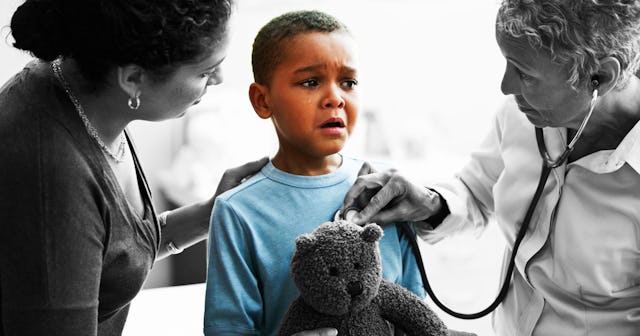The Emotional Safety Initiative Helps Kids Feel More Comfortable With Medical Procedures

In the earliest weeks of the pandemic, my daughter who had a respiratory infection for the better part of the prior winter, began to wheeze. She’d begun to wake up in the middle of the night, needing a nebulizer treatment. I panicked. My first instinct—COVID. Her pediatrician wrote a prescription for a COVID test.
Back in those earliest weeks, the only way to get a COVID test was via a nasal swab administered by a person in a hazmat suit who reached into the car window. My daughter gritted her teeth and let herself be swabbed. (She was negative—phew!) Nearly a year later, she is marked by the experience, and will tell anyone about the “swab that touched her brain” in vivid detail.
Her experience left her, luckily, only with a story to tell. For others, the experience could create a lifelong fear and mistrust of medical environments. That’s the scenario Child Life Specialists work to prevent, and the Emotional Safety Initiative is one way they hope to accomplish that.
Scary Mommy spoke with Kim Stephens, President of the Association of Child Life Professionals (ACLP) about the Emotional Safety Initiative and the newly released paper calling for an emphasis on prioritizing children’s emotional safety along with their physical safety in medical settings.
What Is The Emotional Safety Initiative?
The Emotional Safety Initiative is a movement to prioritize emotional safety at the same level as physical safety in all pediatric medical experiences.
Emotional safety “is an intentional, interdisciplinary practice to promote resiliency, healing, and trust for pediatric patients and their families during medical experiences,” according to a press release from the ACLP. In practice, it’s providing patients and their families with an experience that is stress free and emotionally supportive, says Stephens.
The Emotional Safety Initiative Is A Four-Part Framework
Four key elements create the framework of the emotional safety initiative. They are:
Screening and Assessment
The purpose of this prong is to understand patients and their families in order to create a supportive system, explains Stephens. The assessment is necessary to get a sense of families’ experiences, strengths, and the challenges they’ve faced. It can be done in advance of an admission, in the case of a planned admission, or done on the fly in the case of an emergency room situation.
Intervention
This prong’s focus is on the child’s comfort and gaining an understanding of their prior encounters with medical procedures. The purpose of this prong, according to Stephens is to “understand what was…hard so we can work and try not to replicate that.”
Environment
Stephens notes that for children, everything in a medical environment is scary—from the way adults are dressed to the size of the bed. This prong of the initiative encourages healthcare providers to create a child-friendly environment. To see an example of this prong in action, Stephens points to how her hospital building is constructing a fourth bed tower and in the design of the rooms is considering where parent beds might be positioned to be most supportive to the child.
Education, Training, and Communication
Everybody from the security guard at the front door to the food delivery person, to the medical resident and provider is a part of a patient’s emotional safety. This prong aims to “educate all teams about emotional safety standards.”
Michael H/Getty
Emotional Safety Is As Important As Physical Safety
According to the National Child Traumatic Stress Network, 80% of pediatric patients and families experience some traumatic stress after medical treatment for life-threatening illnesses or injuries.
Short-term effects of traumatic stress post medical treatments can include developmental regressions and difficulty sleeping. Long-term effects can be more severe. Children who have difficult experiences may be unable to trust and seek healthcare as an adult.
In her interview with Scary Mommy, Stephens told the tragic story of a family member who developed a disease when she was just seven. At the time, not only was emotional safety not prioritized but parents were only allowed to visit children during visiting hours. The family member had seven surgeries and was hospitalized for a year. As an adult, she developed a deep-seated fear of healthcare settings and providers and wouldn’t seek medical attention. Ultimately, she passed away from a condition that was very treatable.
This is obviously a tragic and extreme story, but it highlights the very real and long-lasting fear that drives Child Life Professionals to protect emotional safety.
Parents Can Support Emotional Safety, Too
The number one way parents can support emotional safety is to understand what the impact of a medical procedure can be. Parents should be aware that even a simple procedure (like a scary nose swab by a person in a hazmat suit) can have long-term effects that aren’t necessarily solved by going out for ice cream afterward, Stephens notes.
It’s also important that parents are not afraid to ask questions and that they know what their options are. Stephens urges parents to remember that they are the experts on their own children.
For more information, parents can find a guide on the Emotional Safety Initiative website to help them understand what questions to ask healthcare providers and how best to access emotionally safe care.
Ultimately, the goal of the Emotional Safety Initiative is to help healthcare providers and parents recognize “that by providing emotionally safe care you’re impacting both the physical and mental well-being of patients and families,” says Stephens.
Emotional safety “has a lot of impact on health access later in life, especially in pediatrics,” and it cannot be ignored. It’s an important part of fostering a healthy lifelong relationship with healthcare settings.
This article was originally published on